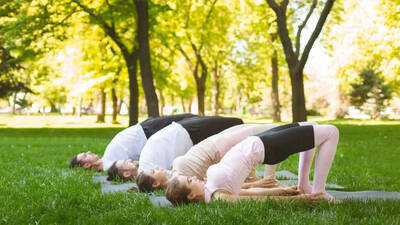Back pain over 50? Discover how THIS exercise strengthens your core and lower back

Back pain is a common concern for adults over 50, often resulting from weakened core muscles, reduced flexibility, poor posture, or age-related changes in the spine. Daily activities, such as bending, lifting, or even sitting for long periods, can place additional strain on the lower back. While various exercises can help alleviate discomfort, the glute bridge is particularly effective. This exercise targets the gluteal muscles, hamstrings, and lower back, while engaging the core to stabilise the spine. Regular practice can strengthen these key muscles, improve posture, support the pelvis, and help prevent or reduce chronic lower back pain in older adults.
Why glute bridges help with back pain
The glute bridge primarily targets the gluteal muscles, hamstrings, and lower back muscles. Strengthening these areas provides better support for the pelvis and spine, improving posture and reducing the strain that often leads to lower back pain. In addition, glute bridges engage the core, which helps stabilise the spine during daily movements.
According to a study published in the , exercises that strengthen the glutes and core can reduce chronic lower back pain and improve mobility, particularly in adults over 50. The study found that participants who engaged in hip muscle strengthening exercises, including glute bridges, experienced significant reductions in low back pain and improvements in lumbar muscle strength and balance. These benefits were particularly notable in individuals aged 30 to 50, suggesting that glute strengthening exercises can be effective in managing and preventing lower back pain in older adults.
How to perform a glute bridge
Step-by-step instructions:
1. Start position: Lie on your back with your knees bent and feet flat on the floor, hip-width apart. Place your arms by your sides with palms facing down.
2. Engage core: Tighten your abdominal muscles to stabilise your spine.
3. Lift hips: Press through your heels and lift your hips toward the ceiling until your body forms a straight line from your shoulders to your knees.
4. Hold position: Pause at the top for 3–5 seconds, squeezing your glutes and keeping your core engaged.
5. Lower hips: Slowly lower your hips back to the floor without letting your lower back arch excessively.
Perform 10–15 repetitions, completing 2–3 sets.
Tips for maximising benefits of glute bridges
- Focus on form: Avoid arching your lower back; the lift should come from your glutes, not your spine.
- Controlled movement: Perform each repetition slowly and deliberately to engage the muscles fully.
- Add difficulty gradually: Once comfortable, try single-leg glute bridges or place a resistance band around your thighs to increase intensity.
- Consistency matters: Performing glute bridges 3–4 times per week can help strengthen the glutes and reduce lower back pain over time.
Benefits of glute bridges for adults over 50
- Reduces lower back pain: Strengthening glutes and core muscles alleviates pressure on the spine.
- Improves posture: Strong glutes and hamstrings support the pelvis and prevent slouching.
- Enhances mobility: Engaging the posterior chain improves walking stability and balance.
- Prevents injuries: Strong glutes reduce the risk of hip, knee, and lower back injuries.
Disclaimer: This article is for informational purposes only and does not constitute medical advice. Always consult a qualified healthcare professional before making any changes to your health routine or treatment.
Also read |
 Back pain is a common concern for adults over 50, often resulting from weakened core muscles, reduced flexibility, poor posture, or age-related changes in the spine. Daily activities, such as bending, lifting, or even sitting for long periods, can place additional strain on the lower back. While various exercises can help alleviate discomfort, the glute bridge is particularly effective. This exercise targets the gluteal muscles, hamstrings, and lower back, while engaging the core to stabilise the spine. Regular practice can strengthen these key muscles, improve posture, support the pelvis, and help prevent or reduce chronic lower back pain in older adults.
Back pain is a common concern for adults over 50, often resulting from weakened core muscles, reduced flexibility, poor posture, or age-related changes in the spine. Daily activities, such as bending, lifting, or even sitting for long periods, can place additional strain on the lower back. While various exercises can help alleviate discomfort, the glute bridge is particularly effective. This exercise targets the gluteal muscles, hamstrings, and lower back, while engaging the core to stabilise the spine. Regular practice can strengthen these key muscles, improve posture, support the pelvis, and help prevent or reduce chronic lower back pain in older adults.